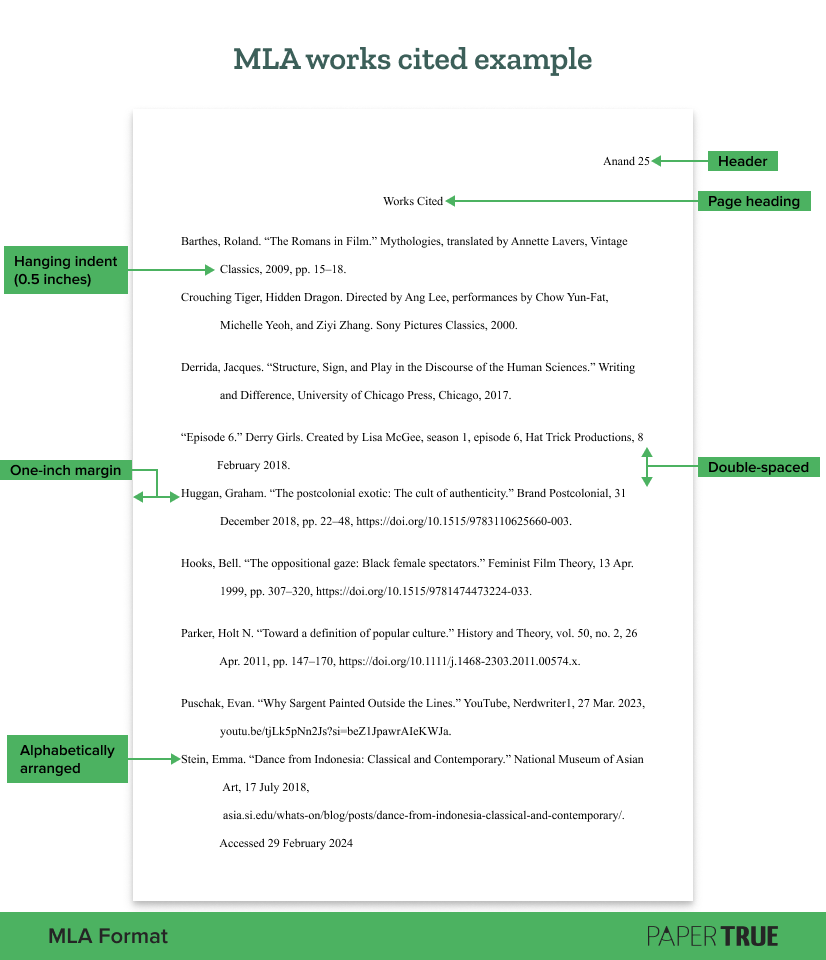Still have questions? Leave a comment

Checklist: Dissertation Proposal
Enter your email id to get the downloadable right in your inbox!

Examples: Edited Papers
Enter your email id to get the downloadable right in your inbox!
Need
Editing and
Proofreading Services?

MLA Works Cited Page: Quick Tips & Examples
 Apr 04, 2024
Apr 04, 2024 6
min read
6
min read
- Tags: Academic Writing, MLA Citations, MLA Style
An MLA reference page, which you may know as the MLA works cited page, can be confusing for many students. For starters, the ninth edition of the MLA Handbook also allows a bibliography, which is quite similar to a list of works cited. So do you need an MLA format works cited page or a bibliography?
What are the rules for listing works cited in MLA format? How should you format individual entries? What should you include in them? We’ve answered all the questions you could have about the MLA works cited page format.
If you’re a visual learner, we’ve created an MLA works cited example, complete with labels. If you’d like a template, let us know in the comments and we’ll add one!
Bibliography vs. works cited: What is the difference?
Although they’re sometimes used interchangeably, bibliography and list of works cited are different from each other.
Bibliography: A list of all the works consulted by the author during their research.
Works cited: A list of all the works directly referred to (cited) in the document.
You may use a bibliography to list all the works related to your work so readers can use them for further research. A list of works cited, however, merely holds complete entries for all in-text citations in your document.
An MLA annotated bibliography contains a note corresponding to each entry, explaining its relevance to your research.
MLA works cited page: Formatting guidelines
Here’s how to format an MLA works cited page:
- Place the works cited page after the body of your paper or thesis.
- Maintain a one-inch margin on all sides.
- Add an MLA header (last name and page number) in the upper right corner.
- Double-space the entire page.
- Use an 11- to 13-point standard font (Times New Roman, Arial, Georgia, or Calibri).
- At the top of the page, add the heading “Works Cited” and center it.
- Keep the heading consistent with others in the document.
- Left-align the citations.
- Add citations in alphabetical order by the first letter of your MLA format citation. (This is usually the author’s last name, but may be other entities as well.)
- Add a hanging indent (0.5 inches for the second and subsequent lines of the citation) through the indentation options in Word or Docs.
In case you’re confused, scroll down and check out the MLA works cited page example. That should clarify things!
A list of works cited in MLA style should have an entry corresponding to every in-text citation in the document. If you use a source without crediting the author, you’re effectively plagiarizing their work. Needless to say, this is very bad for your paper, dissertation, or research article! Not to mention, it undermines your academic integrity.
Note: If you’re citing only one source, the page heading will be “Work Cited”.
How to format entries in an MLA format reference page
This is the general format for entries on an MLA reference page:
Author’s Last Name, First Name. “Title of the source.” Title of the container, Other Contributor’s First Name, Last Name, version, number, Publisher, publication date, location.
Here’s a corresponding example:
Barthes, Roland. “The Romans in Film.” Mythologies, translated by Annette Lavers, Vintage Classics, 2009, pp. 15–18.
An author’s name in the MLA works cited format is always inverted. But this changes if a work has more than one author. These are the three variations you can use while writing the author’s name in the MLA 9 format:
Note: The page range (indicated by p. or pp.), URL, and DOI for a source are its “location” within a container, whether a book or database.
While writing your paper or dissertation, you may come across sources that don’t follow the MLA works cited format mentioned above. So let’s take a look at some popular sources and the most common ways to cite them.
1. Book
Here’s how to format a book citation in MLA 9:
Author(s). Book Title. Edition no. (2nd onwards), Publication city, Publisher, Publication year.
Morrison, Toni. Paradise. 3rd ed., Vintage Classics, 2018.
Remember these formatting tips while citing a book:
- If a book has only editors and no writers, mention the editors as its “authors”.
- While citing a self-published book, no publisher details are required except the year of publication.
2. Book chapter
If there’s no editor for the entire work, you may leave out that detail. Here’s how to include a book chapter to your works cited page in MLA format:
Author(s). “Chapter Title.” Book Title: Subtitle, edited by [Editor(s)], Publisher, year of publication, page range.
Paster, Gail Kern. “The tragic subject and its passions.” The Cambridge Companion to Shakespearean Tragedy, edited by Claire McEachern, Cambridge University Press, Cambridge, United Kingdom, 2013, pp. 142–160.
Observe how in the chapter title above, we’ve preserved the capitalization convention of the original. That’s what you should do!
3. Journal article
A DOI is a simple way for your readers to find an article, so always mention it if one is available. If a DOI or permalink isn’t available, you may mention the URL. Here’s the MLA 9 format for citing a journal article:
Author(s). “Article title.” Journal Name, volume, issue number, year of publication, (pages). DOI or URL. 2nd container name.
Huggan, Graham. “The postcolonial exotic: The cult of authenticity.” Brand Postcolonial, 31 Dec. 2018, pp. 22–48, https://doi.org/10.1515/9783110625660-003.
You’ll usually find these details on the title page of the articles you’ve referred to. If an author isn’t listed, the works cited entry should begin with the article title.
4. Website
While citing a website, remember to credit the publisher. You can often find this in the copyright details at the bottom of the page. If the publisher/sponsor is the same as the website named, you don’t have to name it a second time. Here’s how to include a website to a works cited page in MLA format:
Author name(s). “Title of the Webpage.” Title of the Website, Publisher, day-month-year of publication, URL. Accessed day-month-year.
Stein, Emma. “Dance from Indonesia: Classical and Contemporary.” National Museum of Asian Art, 17 Jul. 2018, asia.si.edu/whats-on/blog/posts/dance-from-indonesia-classical-and-contemporary/. Accessed 29 Feb. 2024
5. Video
Here are the formats for citing a streaming video, movie, and TV episode:
Author(s). “Title of Video.” Title of the Hosting Website, day-month-year of publication, URL of video.
Title of Movie. Director, performers. Production Company, year of release.
“Title of Episode.” Title of TV Series. Contributors(s), season, episode, Production Company, day-month-year of release.
These are the corresponding MLA reference page examples:
Puschak, Evan. “Why Sargent Painted Outside the Lines.” YouTube, Nerdwriter1, 27 Mar. 2023, youtu.be/tjLk5pNn2Js?si=beZ1JpawrAIeKWJa.
Crouching Tiger, Hidden Dragon. Directed by Ang Lee, performances by Chow Yun-Fat, Michelle Yeoh, and Ziyi Zhang. Sony Pictures Classics, 2000.
“Episode 6.” Derry Girls. Created by Lisa McGee, season 1, episode 6, Hat Trick Productions, 8 Feb. 2018.
While citing a TV episode, include the contributors most relevant to your research. If you’re exploring Clare’s identity through the episode, you should name the actress Nicola Coughlan. But if you’re simply researching Irish history, mentioning the creator is just fine.
Want to find out how to cite plays, poetry, and the Bible? Maybe our guide on MLA citation examples can help!
MLA works cited example
We know that it’s never enough to merely list the formatting instructions. Visual aids are always necessary! Here’s an MLA works cited page example:

That concludes our guide on how to format an MLA works cited page. We hope the MLA format works cited example helped. If you need a second opinion on your writing, our paper editing services are at your disposal. All the best!
If you’d like to keep reading about academic writing and formatting, here are some more resources:






